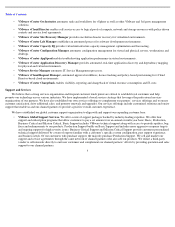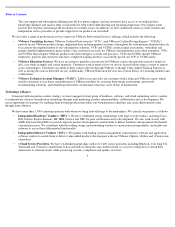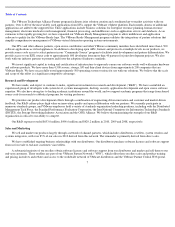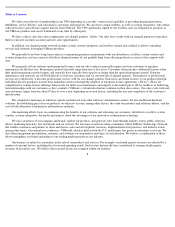VMware 2010 Annual Report Download - page 18
Download and view the complete annual report
Please find page 18 of the 2010 VMware annual report below. You can navigate through the pages in the report by either clicking on the pages listed below, or by using the keyword search tool below to find specific information within the annual report.
Table of Contents
If operating system and hardware vendors do not cooperate with us or we are unable to obtain early access to their new products, or access to
certain information about their new products to ensure that our solutions interoperate with those products, our product development efforts
may be delayed or foreclosed.
Our products interoperate with Windows, Linux and other operating systems and the hardware devices of numerous manufacturers.
Developing products that interoperate properly requires substantial partnering, capital investment and employee resources, as well as the
cooperation of the vendors or developers of the operating systems and hardware. Operating system and hardware vendors may not provide us
with early access to their technology and products, assist us in these development efforts or share with or sell to us any application programming
interfaces, or APIs, formats, or protocols we may need. If they do not provide us with the necessary early access, assistance or proprietary
technology on a timely basis, we may experience product development delays or be unable to expand our products into other areas. To the extent
that software or hardware vendors develop products that compete with ours or those of our controlling stockholder, EMC, they may have an
incentive to withhold their cooperation, decline to share access or sell to us their proprietary APIs, protocols or formats or engage in practices to
actively limit the functionality, or compatibility, and certification of our products. To the extent that we enter into collaborations or joint
development and marketing arrangements with certain hardware and software vendors, vendors who compete with our collaborative partners
may similarly choose to limit their cooperation with us. In addition, hardware or operating system vendors may fail to certify or support or
continue to certify or support our products for their systems. If any of the foregoing occurs, our product development efforts may be delayed or
foreclosed and our business and results of operations may be adversely affected.
Our new product and technology initiatives subject us to additional business, legal and competitive risks.
Over the last several years, we have introduced new product and technology initiatives that aim to leverage our virtualization infrastructure
software products into the emerging areas of cloud computing and end-user computing as alternatives to the provisioning of physical computing
resources. In connection with our September
15
•
our ability to develop, introduce and ship in a timely manner new products and product enhancements that meet customer demand,
certification requirements and technical requirements;
•
the timing of the announcement or release of upgrades or new products by us or by our competitors;
•
our ability to maintain scalable internal systems for reporting, order processing, license fulfillment, product delivery, purchasing,
billing and general accounting, among other functions;
•
our ability to control costs, including our operating expenses;
•
changes to our effective tax rate;
•
the increasing scale of our business and its effect on our ability to maintain historical rates of growth;
•
our ability to attract and retain highly skilled employees, particularly those with relevant experience in software development and
sales;
•
our ability to conform to emerging industry standards and to technological developments by our competitors and customers;
•
renewal rates for ELAs as original ELA terms expire;
•
the timing and amount of software development costs that are capitalized beginning when technological feasibility has been
established and ending when the product is available for general release;
•
unplanned events that could affect market perception of the quality or cost
-
effectiveness of our products and solutions; and
•
the recoverability of benefits from goodwill and intangible assets and the potential impairment of these assets.
























